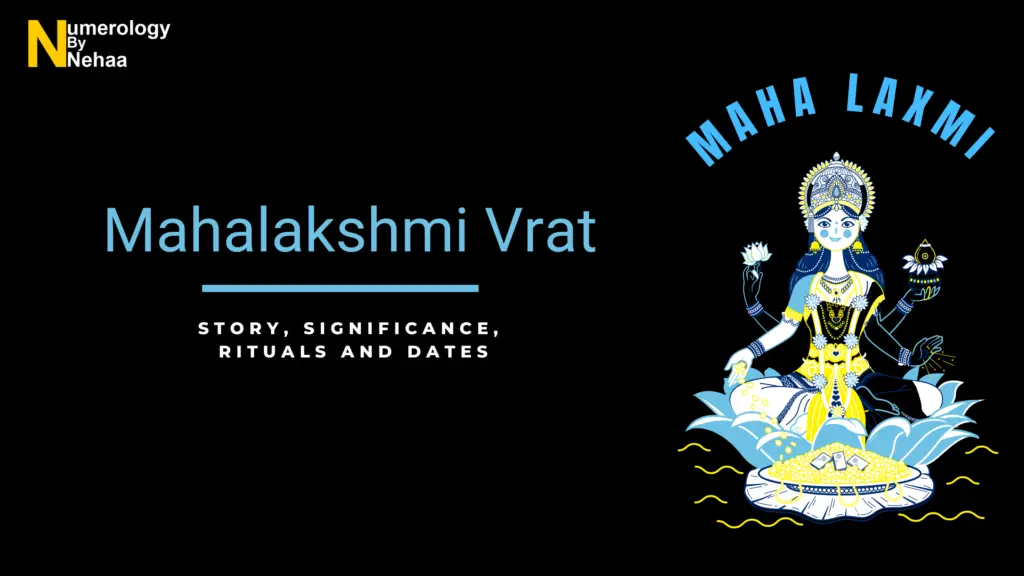
Mahalakshmi Vrat is observed for a period of sixteen consecutive days, starting from the ‘Ashtami’ (8th day) of the Shukla Paksha (the waxing phase of the moon) in the Hindu Calendar month of ‘Bhadrapada’ and ends on ‘Krishna Paksha Ashtami’ (8th day during the waning phase of moon) of the ‘Ashwin’ month. In the Gregorian calendar, this period falls in the month of September-October.
The fasting starts four days after the auspicious Ganesh Chaturthi festival and continues till the eight day of the Pitru Paksha (the fortnight dedicated to ancestors) period. In Mahalakshmi Vrat Hindu devotees keep a strict fast for Goddess Lakshmi and receive Her divine blessings. This vrat is observed with full fervour and dedication in the northern regions of India such as Uttar Pradesh, Bihar and Madhya Pradesh.
| Year | Date |
|---|---|
| 2017 | Tuesday, 29th of August |
| 2018 | Monday, 17th of September |
| 2019 | Friday, 6th of September |
| 2020 | Tuesday, 25th of August |
| 2021 | Monday, 13th of September |
| 2022 | Saturday, 3rd of September |
| 2023 | Friday, 22nd of September |
| 2024 | Wednesday, 11th of September |
| 2025 | Sunday, 31st of August |
| 2026 | Friday, 18th of September |
| 2027 | Tuesday, 7th of September |
On the day of Mahalakshmi Vrat (Bhadrapada Shukla Ashtami), devotees wake up at sunrise and take an early bath. Special prayers are offered to Goddess Lakshmi every morning for 16 continuous days. All the eight forms of Mahalakshmi are worshipped during this period.
In some regions, devotees also worship Surya Bhagwan during this period. Devotees offer ‘aargya’ to Sun God everyday at the time of sunrise.
As a part of the ritual, sixteen knots are tied in a string and the observer of Mahalakshmi Vrat wears it on his/her left hand.
Devotees worship the idol of Goddess Lakshmi with utmost dedication and pray the Goddess to shower happiness and prosperity on their entire family. After the puja, sixteen Durva grass is tied together. It is dipped in water and then sprinkled over the body. At the end of the puja, Mahalakshmi Vrat Katha is recited every day.
The observer of Mahalakshmi Vrat follows it for complete 16 days with full austerity. Eating non-vegetarian food is completely restricted during this period.
During Mahalakshmi Vrat, reading religious books like ‘Lakshmi Sahasranaam’, ‘Satanamavali’ and ‘Lakshmi Ashtottara’ is considered to be highly beneficial.
The fast is ended on Ashwin Krishna Ashtami after offering evening prayers to Goddess Lakshmi. On the last day, a Purna Kumbha or Kalash is worshipped. The Kalash is filled with water, a few coins, and akshatas. The neck is covered with mango or betel leaves, with a coconut placed on the top. During the puja, the Kalash or Purna Kumbha and coconut are smeared with sandalwood, turmeric paste, and kumkum. A new and fresh cloth is tied to the Kalash, which is emblematic of Goddess Lakshmi and worshipped by the devotees. On the last day, nine different varieties of sweets and savories are prepared for offering to Goddess Lakshmi. It is later distributed as Prasad among all friends and family members.
Mahalakshmi Vrat is an important fasting day observed by Hindus men and women. The glory of this sacred vrat was explained by Lord Sri Krishna to King Yudhisthira, the eldest of the Pandav brothers. The greatness of Mahalakshmi Vrat is also stated in religious scriptures like ‘Bhavishya Purana’.
Mahalakshmi Vrat is celebrated in honor of Goddess Lakshmi, who is the consort of Lord Vishnu and also considered to be a form of Maa Shakti. The holy vrat starts from the Bhadrapada Shukla Ashtami that is also celebrated as Radha Ashtami, the birthday of Goddess Radha (the companion of Lord Krishna).
This day is also significant as it corresponds with Dhruva Ashtamiin which Durva grass is worshipped. Moreover, the same day is also celebrated as ‘Jyeshta Devi Puja’ and continues until three days. The observer of Mahalakshmi Vrat has bestowed with blessings of Goddess Lakshmi all his/her life.
Fill the below details